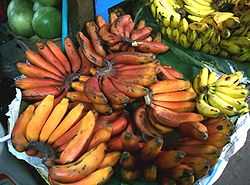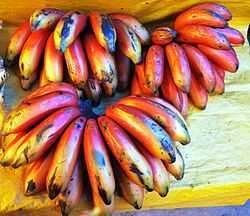Red banana
| Musa acuminata 'Red Dacca' | |
|---|---|
 Red banana plant from Tanzania showing fruits and inflorescence. | |
| Details | |
| Species | Musa acuminata |
| Cultivar group | AAA Group (Cavendish group) |
| Cultivar | 'Red Dacca' |
| Origin | West Indies and Central America |

Red bananas, also known as Red Dacca bananas in Australia, are a variety of banana with reddish-purple skin. They are smaller and plumper than the common Cavendish banana. When ripe, raw red bananas have a flesh that is cream to light pink in color. They are also softer and sweeter than the yellow Cavendish varieties, with a slight raspberry flavor. Many red bananas are imported from producers in Asia and South America. They are a favorite in Central America but are sold throughout the world.
Taxonomy and nomenclature
The Red banana is a triploid cultivar of the wild banana Musa acuminata, belonging to the Cavendish group (AAA).[1]
Its official designation is Musa acuminata (AAA Group) 'Red Dacca'.
Synonyms include:
- Musa acuminata Colla (AAA Group) cv. 'Red'
- Musa sapientum L. f. rubra Bail.
- Musa sapientum L. var. rubra (Firm.) Baker
- Musa rubra Wall. ex Kurz.
- Musa × paradisiaca L. ssp. sapientum (L.) Kuntze var. rubra
- Musa acuminata Colla (AAA Group) cv. 'Cuban Red'
- Musa acuminata Colla (Cavendish Group) cv. 'Cuban Red'
- Musa acuminata Colla (AAA Group) cv. 'Red Jamaican'
- Musa acuminata Colla (AAA Group) cv. 'Jamaican Red'
- Musa acuminata Colla (AAA Group) cv. 'Spanish Red'.
It is known in English as Red dacca, Red banana, Claret banana, Cavendish banana "Cuban Red", Jamaican red banana, and Red cavendish banana. It is also known under a variety of common names in other countries, including the following:
- Burmese: Shwe nget pyaw.
- Chinese: Hong guo jiao.
- Danish: Kubabanan, Aeblebanan, Rød banan.
- Dutch: Rode banaan, Cubabanaan.
- French: Figue rose (Guadeloupe, Martinique), Figue rouge (Haiti), Figue rouge-vin, Figue violette (Guadeloupe), Bacove violette (French Guiana), Banane rouge, Banane violette, Banane de Cuba
- German: Weinrote Banane, Kuba Banane
- Hindi: Lal kela, Lal kera
- Indonesia: Pisang Susu Merah
- Italian: Banana rosa, Banana di Cuba
- Japanese: Baracoa
- Malaysian: Pisang raja udang
- Portuguese: Banana roxa (Brazil), Bananeira roxa, Banana vermelha
- Polish: Czerwony banan (Poland),
- Sinhalese: Rathambala රතඹලා
- Spanish: Banano color clarete, Tafetan (Colombia), Tafetan morado (Colombia), Guineo morado (Cuba), Colorado (Puerto Rico), Platano colorado, Plátano rosado (Ecuador), Plátano rojo (Perú)
- Tagalog: Morado
- Tamil: Sevvazhai செவ்வாழை
- Thai: Kluay nak (กล้วยนาก)
- Malayalam: Chovazha, Chenkadali, Kappa Pazham
Description
Red bananas should have a deep red or maroon rind when ripe, and are best eaten when unbruised and slightly soft. The redder the fruit, the more carotene and the higher the vitamin C level.[2] As with yellow bananas, red bananas will ripen in a few days at room temperature and are best stored outside refrigeration.
Uses
Red bananas are eaten in the same way as yellow bananas, by peeling the fruit before eating. They are frequently eaten raw, whole or chopped, and added to desserts and fruit salads, but can also be baked, fried and toasted. Red bananas are also commonly sold dried in stores.
The first bananas to appear on the market in Toronto (in the 1870s and 1880s) were red bananas.[3] Red bananas are available year round at specialty markets and larger supermarkets in the United States.
Diseases
See also
References
- ↑ Michel H. Porcher; Prof. Snow Barlow (2002-07-19). "Sorting Musa names". The University of Melbourne, . Retrieved 11 January 2011.
- ↑ "Red Bananas Fruit Profile". Chiquita Bananas.
- ↑ John V McAree (1953) The Cabbagetown Store (Toronto: Ryerson Press) p. 19.
- ↑ Encanto Farms: Red Dacca
http://www.bmccorner.com/2014/01/red-bananas-and-its-nutrional-values.html
External links
| Wikimedia Commons has media related to Red banana. |
| |||||||||||||
| |||||||||||||||||||||||||||||||||||||||
http://www.bmccorner.com/2014/01/red-bananas-and-its-nutrional-values.html
